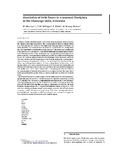| dc.contributor.author | Mladenov, N. | |
| dc.contributor.author | McKnight, D.M. | |
| dc.contributor.author | Wolski, P. | |
| dc.contributor.author | Murray-Hudson, M. | |
| dc.date.accessioned | 2010-06-09T13:02:58Z | |
| dc.date.available | 2010-06-09T13:02:58Z | |
| dc.date.issued | 2007 | |
| dc.identifier.citation | Mladenov, N. et al (2007) Simulation of DOM fluxes in a seasonal floodplain of the Okavango Delta, Botswana, Ecological Modelling, Vol. 205, pp. 181–195 | en_US |
| dc.identifier.issn | 0304-3800 | |
| dc.identifier.uri | http://hdl.handle.net/10311/497 | |
| dc.description.abstract | In order to examine dissolved organic matter (DOM) fluxes in seasonal wetland systems
that expand and contract seasonally, a time-variable model of dissolved organic carbon
(DOC) was developed for a seasonal floodplain in the Okavango Delta of Botswana. The
model simulates DOC concentrations from March 2001 to November 2002, during which
time DOC concentrations varied between 8 and 31mgCL−1. The model uses a continuously
stirred tank reactor (CSTR) approach to describe the hydrologic and biogeochemical controls
on DOC leached from litter within the floodplain and transported into the floodplain from
upstream. In 2002, a fire burned the floodplain and less litter was available for leaching than
in 2001. The model was driven by observations of discharge, water temperature, upstream
DOC concentrations, and DOC leaching rates from leaching experiments. Leaching experiments
with sedges and grasses indicated that on average 23mgDOCg−1 were leached during
the first day ofwetting and 0.6mgDOCg−1 d−1 were continuously leached afterwards. Leaching
experiments also showed a decreased amount of DOC released from burned litter and
soils than from unburned litter and soils. A two-pool first-order decaymodel that represents
both rapidly (0.14 d−1 (at 22 ◦C)) and slowly (0.045 d−1) decaying pools of DOC provided the
best representation of observed patterns in DOC concentration in 2001. The decay rate of
the first pool decreased by nearly half in 2002, when an estimated 78% of litter was removed
by fire.
Upstream DOC transport into the floodplain was the dominant source of DOC (representing
approximately 70% and 75% of the DOC input in 2001 and 2002, respectively), followed
by DOC leaching from litter and DOC originating from microbial sources. In 2001, decomposition
(representing approximately 36% of the DOC loss), outflow to an adjacent floodplain
(36%) and infiltration (28%) were the major removal mechanisms for DOM from the study
floodplain. The large amount of DOC transported by infiltration implies storage of DOC in the
subsurface, whichmay influence subsurface heterotrophic activity. In light of future climate
change anticipated for the region, a scenario using a 2 ◦C increase in average water temperature
and 10% reduction in upstream DOC mass was performed and resulted in significant
(11%) reduction in annual DOC mass within the study floodplain. | en_US |
| dc.language.iso | en | en_US |
| dc.publisher | Elsevier, www.elsevier.com/locate/ecolmodel | en_US |
| dc.subject | DOC | en_US |
| dc.subject | Model | en_US |
| dc.subject | CSTR | en_US |
| dc.subject | Decay | en_US |
| dc.subject | Leaching | en_US |
| dc.subject | Degradation | en_US |
| dc.subject | Infiltration | en_US |
| dc.subject | Floodplain | en_US |
| dc.subject | Wetland | en_US |
| dc.subject | Okavango Delta | en_US |
| dc.subject | Africa | en_US |
| dc.subject | Fire | en_US |
| dc.subject | Burning | en_US |
| dc.title | Simulation of DOM fluxes in a seasonal floodplain of the Okavango Delta, Botswana | en_US |
| dc.type | Published Article | en_US |

